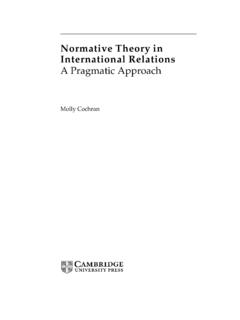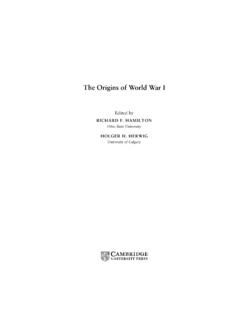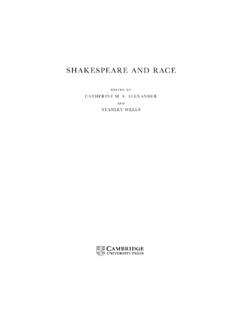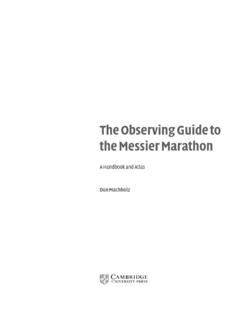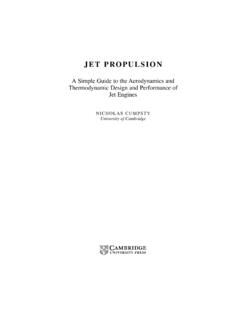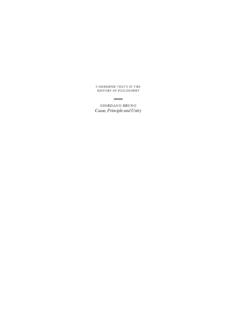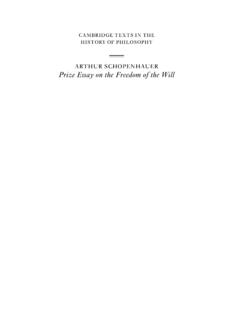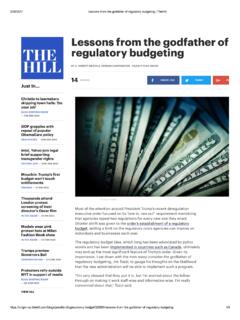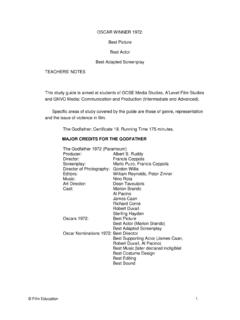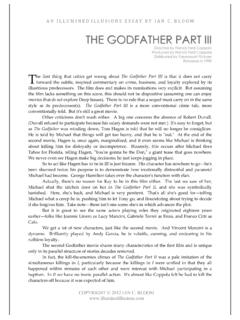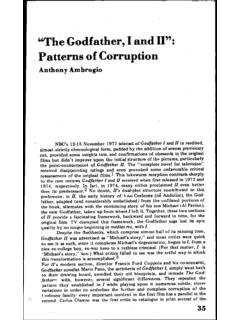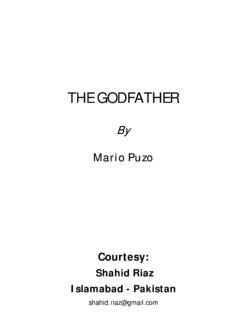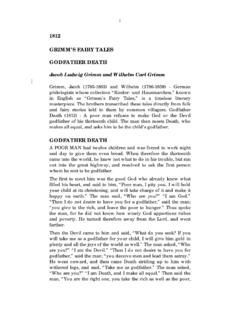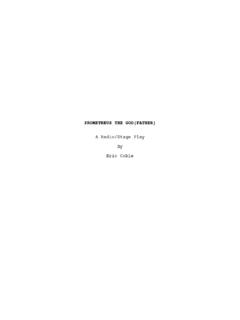Transcription of Godfather Trilogy - The Library of Congress
1 Francis Ford Coppola s Godfather TrilogyEdited byNICK BROWNEPUBLISHED BY THE PRESS SYNDICATE OF THE UNIVERSITY OF CAMBRIDGEThe Pitt Building, Trumpington Street, Cambridge, United KingdomCAMBRIDGE UNIVERSITY PRESSThe Edinburgh Building, Cambridge CB2 2RU, West 20th Street, New York, NY10011-4211, Stamford Road, Oakleigh, Melbourne 3166, AustraliaRuiz de Alarc n 13, 28014 Madrid, Spain Cambridge University Press 2000 This book is in copyright. Subject to statutory exceptionand to the provisions of relevant collective licensing agreements,no reproduction of any part may take place withoutthe written permission of Cambridge University published 2000 Printed in the United States of AmericaTypeface Stone Serif QuarkXPress [GH]A catalog record for this book is available from the British of Congress Cataloging-in-Publication DataFrancis Ford Coppola s Godfather Trilogy / edited by Nick Brownep.
2 Cm. (Cambridge film handbooks)Filmography: bibliographical references and 0-521-55084-X (hardcover)1. Godfather films History and criticism. I. Browne, Series. Cambridge film handbooks 75 dc2199-17674 CIPPISBN 0 521 55084 X hardbackISBN 0 521 55950 2 paperbackviiContentsAcknowledgmentspage xiList of ContributorsxiiiFearful A-SymmetriesViolence as History in the Godfather FilmsNICK BROWNE11If History Has Taught Us Anything .. Francis Coppola,Paramount Studios, and The Godfather Parts I, II, and IIIJON LEWIS232 The Godfatherand the Mythology of MafiaALESSANDRO CAMON573 The Representation of Ethnicity in The GodfatherVERA DIKA764 Ideology and Genre in the Godfather FilmsGLENN MAN1095 Family Ceremonies: or, Opera in The Godfather TrilogyNAOMI GREENE133 Filmography157 Reviews of the Godfather Trilogy167 Select Bibliography183 Index185 Francis Ford Coppola, the director.
3 Copyright Paramount Pictures, 1972. Cour-tesy of the Museum of Modern Art Film Stills ArchiveBy almost any account, the Godfatherfilms are monu-ments on the landscape of American cinema. There are, of course,differences of intention and achievement among the three, butthe first one, The Godfather (1972), stands out in popular and criti-cal opinion as one of the enduring works of the American standing of The Godfather Part II(1974), nearly comparable tothe first, lies not only in its art, but in its outlook, so rare in Amer-ican films from early 1970s, on a flawed American protagonist asan emblem of American empire. The Godfather Part IIIbrings outthe theme of redemption present in Coppola s vision from thestart. It is natural to regard these films as a Trilogy to deal with thecontinuity of a directorial vision of the century-long workingthrough of economic crime and punishment in the inner sanctumof an American a commercial venture, The Godfatherand, to a lesser extent,The Godfather Part IIwere blockbusters.
4 In its day, The Godfatherwas one of the most profitable films of all time. Over the years, itis said, the Trilogy did business of more than a billion dollars. TheGodfathercontinues to be loved by the public and remains one ofthe few enduring, still popular classics of American cinema. Thefilms were breakout, critical successes as well, earning more thantwo dozen Academy Award nominations among them. The Godfa-ther(1972) and The Godfather Part II(1974) both won AcademyAwards as Best Picture. Coppola and Puzo won twice for Best1 NICK BROWNEF earful A-SymmetriesVIOLENCE AS HISTORY IN THE GODFATHERFILMSA dapted Screenplay. Coppola won Best Director for DeNiro both won acting awards. Moreover, the first two filmsamounted to a social phenomenon they entered into every levelof American culture high and low sometimes by attitude,sometimes by quotation, and sometimes through their iconic, sig-nature scenes.
5 The first two films entered not only movie history,but American mythology as well, and have stayed there for morethan twenty-five distinctiveness of the Godfathertrilogy lies at the intersec-tion of the national character of the system of American film gen-res and the tradition of the European art cinema. These worksexhibit a very high level of craft in the making of the film. Thesets, costumes, lighting, cinematography, sound, music, editing,and so on together provide an extraordinary level of sensuousdelight in cinematic design and presentation. The Godfatherfilmsare, moreover, deeply rooted in the conventions of the Americancrime film and the social experience of the ambitious outsider thatshapes that genre s attitudes.
6 The distinctiveness of Coppola s andPuzo s adaptation of Puzo s novel lies in its reinterpretation of thegeneric conventions of the crime film in the direction of the fam-ily melodrama and the epic. It is this transformation of subjectmatter that gives the films their popular Coppola aesthetic, that is to say the sensibility and conceptthat informs these works, is at the same time realist and films might even be regarded as antimodernist in the waythey foreground action taking place in the photographed worldwithout the need for special effects and in the understated trans-parency of their cinematic technique. Notwithstanding the factthat some of the most celebrated scenes are those assembled byEisenstein-like juxtaposition (for example, the intercutting of theexecution of the enemies with Michael s godson s baptism thatincludes the line Do you renounce Satan?)
7 , the Coppola aes-thetic is ultimately one of mise-en-sc ne that is to say of act-ing, blocking, and delivery of dialog. The narrative of The Godfa-therpossesses the simplicity of linear development by plausible2 NICK BROWNE complication following reliable dramatic laws of action and reac-tion. Godfather II s narrative architecture the alternation of pre-sent and past taking the viewer back through the century though initially complicating locates the contemporary story ofthe 1950s and 1960s squarely within a chronological presentationof American history. This history takes the form of repetition witha difference namely, underlining the progressive loss of aura andthe weakening justification for violence through a narrative pat-tern of parallelism and counterpoint for example, the compari-son of opening festivals, the decisive act of murder that launchesand establishes both godfathers, and so films power is closely connected to the tour-de-force perfor-mances of Brando and especially Pacino and to the distinctivelyAmerican style of acting the method that they embody.
8 Thebrilliance of Coppola s direction per se (that is, beyond the force-fulness and ingenuity needed to write and cast the films) consistsof two parts. The first is eliciting from actors, individually andtogether, performances that convincingly take the character acrossthe changes of time and experience to render absolutely definitivecrystalizations of Coppola s interpretation of the story as thedecline of honor in the ascent to power. He shapes Brando s aging,judicious, distracted benevolence with the emergence of Pacino smovement away from simple filial duty toward the calculating,aggressive, repressed, and hypocritical killer of foe and family thathe becomes. The second quality of Coppola s direction consists ofthe discovery of a cinematic style, principally through framing andcomposition of individual shots, that gives epic force and meaningto the actors work.
9 It is a cinema of transparency, a cinematic stylethat has no need to call attention to itself but only to display theinherent theatricality of the action taking place in the middle dis-tance, for it is the framelines and the lighting that create dark hol-lows and zones of significant illumination that give meaning tothe actors looks, movement, and lines. This cinematic style doesnot present but discloses the drama. The dialogue is not literarythough it comes from a novel, but seems to issue directly from theFEARFUL A-SYMMETRIES3milieu. The opening shot of The Godfatheris a striking anomaly tothe norm that confirms this thesis. Beginning with a riveting storyof insult and injustice recounted by the undertaker Bonaseradirectly to the camera, the drama unfolds by an almost impercepti-ble slow reverse zoom that moves across the desk to disclose a lis-tener and stops behind the shoulder of the unidentified figure the Godfather as we see in the reverse shot.
10 This technique, pos-sible perhaps only in cinema, clearly defines the space of the actor,aligns it to the principal character, and underlines the inherentlyspatial integrity of the drama. It is this concept of a stable, centeredspace and the determined positions of the actors in the frame thathelps to give the characters their particular dramatic and epicweight. The cinematic frames, though deliberately composed, arerarely beautiful in their own right, but function both to recountthe story and to interpret it by tone, scale, and texture. Rarely hasAmerican cinema made such powerful use of overtones to drama-tize a scene. The importance of Godfather films lies both in theirknowledge and redeployment of the conventions of the genre andin a directoral intelligence operating within the most distinctivetraditions of American theater as adapted to writing on the Godfatherfilms has mostly been from a few articles in small journals, writers of articles andbooks usually have documented the production of the films thatis to say, the hiring of Coppola; the writing, the casting, and theshooting; the history of troubles on the set; the story of the Mafia,and so forth.



